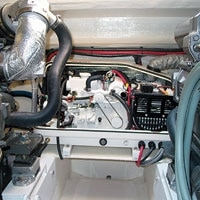
Heading offshore in a buddy’s battlewagon with summer at full strength, we found ourselves gravitating toward the enclosed flybridge, where the blast of cool air conditioning felt like a godsend. It’s a great perk to have on a boat, but you can’t run the A/C unless you have, well, AC. As in alternating current, or 120-volt AC power.
The question is, while offshore, how are you going to get it? That depends on what’s on your boat and how you use it.
Cool Runnings
“What requires AC power are heating and cooling devices,” says Gino Kennedy, who has over 30 years of marine generator experience and is the owner of Next Generation Power Engineering in Jacksonville, Florida. “Such as when you have a microwave, a coffee maker or air conditioning.”
You can deliver AC power on your boat in two ways: from a generator that converts fuel to electricity or from an inverter that turns 12-volt DC (direct current) juice from your batteries into 120-volt AC. An inverter can handle some load, but not much.
“Once you want to run air conditioning, you need a generator,” says Kennedy. Even with no air conditioning on a boat, running high-capacity hot water heaters, electric heating, an electric galley, a large refrigerator or an entertainment system could create the need. The rule is once you have 120-volt components that require, in total, between 1½ and 2 kW to run, it’s generator time.
Why? “Battery power is in the Stone Age,” says Kennedy. They’re heavy for the power provided, and to get enough juice you’d need at least $5,000 to $10,000 worth of batteries that would add serious weight to your boat – the preferred 8D batteries weigh about 125 pounds apiece, so a generator makes more sense.
Small-Block Electric
There’s an easy way to estimate what size generator you’d need on your boat. Add up the watts listed on the 120-volt appliances you want to run offshore. (A microwave and a coffee maker typically draw over 1 kW.) If you see only amps listed, convert to watts with this formula: watts = volts x amps. Pick a generator that will meet your needs at about two-thirds of its output rating.
What’s it going to cost? A 42-foot boat with a single air-conditioning unit would typically need a 3 to 5 kW generator, which would cost between $5,000 and $8,000. Installation costs depend on whether your engine room is set up for a generator option.
Do you have to install another fuel tank or plumb your existing one? Do you need to add an AC panel? A shore-to-generator power switch? Do you add a dedicated starter battery? Expect to pay anywhere between $1,000 to $3,000 for the installation.

|

|

|
Easy install: Many modern generators come as modular units, greatly simplifying installation. Plus, sound shielding (right) makes them much quieter than older sets.
Another question is, gas or diesel? Prevailing wisdom is to go with whatever powers your main engines because it’ll be easier to refuel, and an extra fuel tank adds weight (a gallon of gas weighs 6 pounds; a gallon of diesel weighs 7) and complexity. But diesel generators are more fuel-efficient and require less maintenance, so if your gas-powered boat can handle the extra tank, go diesel.
Inverter Inquiries
Take air conditioning out of the equation, and an inverter becomes more reasonable. For components that draw small AC loads over short periods of time, an inverter should be fine, and it’s quiet. “A lot of people don’t want to hear a generator or smell it,” says Ed Sherman of the American Boat and Yacht Council. Just keep track of the amp hours.
“If you want to do an inverter, you have to do a careful load analysis,” says Sherman. You never want the load to draw the batteries below 50 percent of their capacity. Since inverters run at 90 percent efficiency, you need more battery power than you think.
Plus, Sherman notes, “All inverters are not created equal.”
Some pieces of equipment on your boat, like a high-end audio system or flat-screen TV, are waveform sensitive, meaning they could be damaged by inferior AC output. These require a true sine-wave inverter. True sine wave is more expensive, but it matches the juice you’d get from a wall outlet in your house. A modified sine wave inverter doesn’t produce the same high-quality current but is a lot cheaper.
Figure it all out by whether you want a cool breeze, a hot cup of coffee or both.









